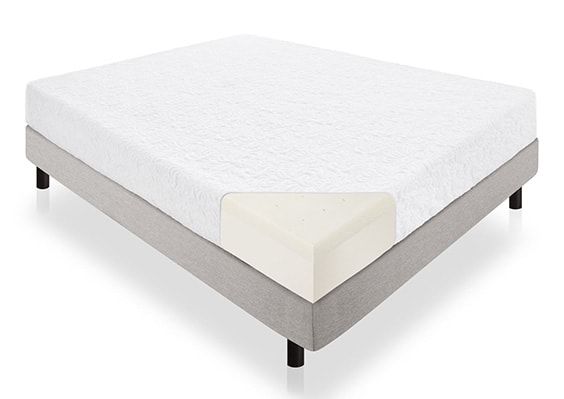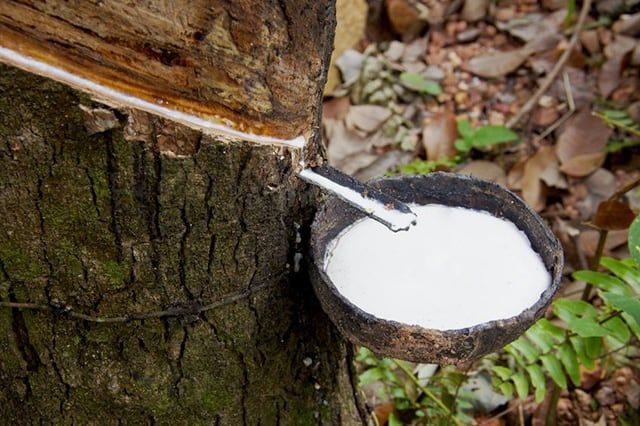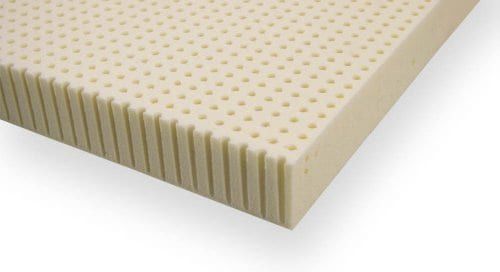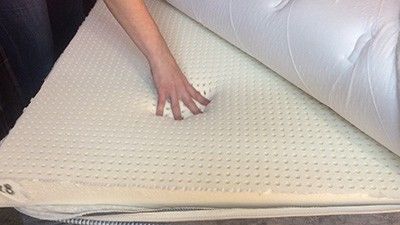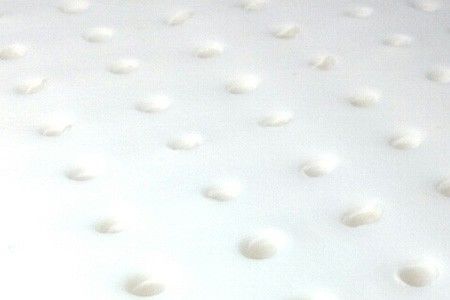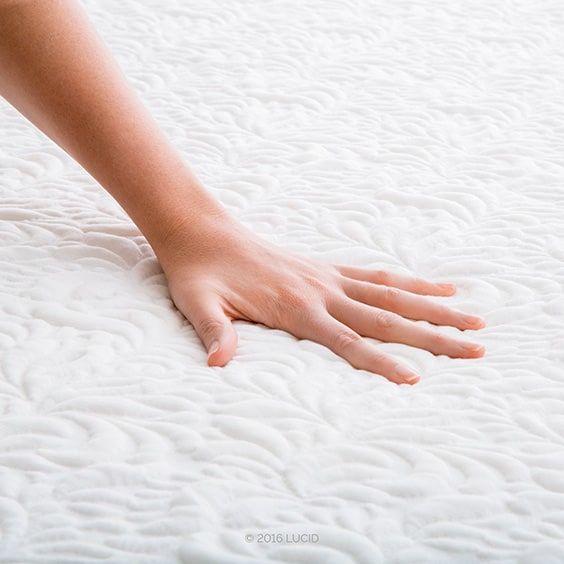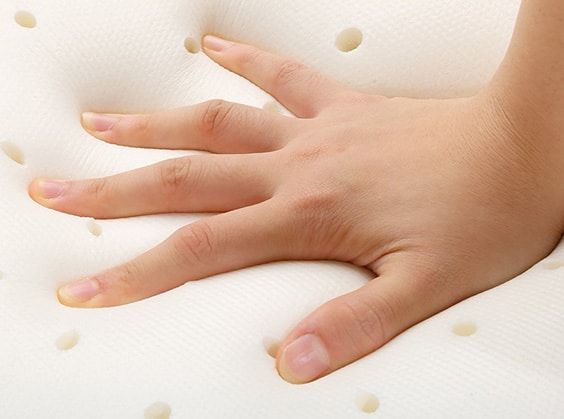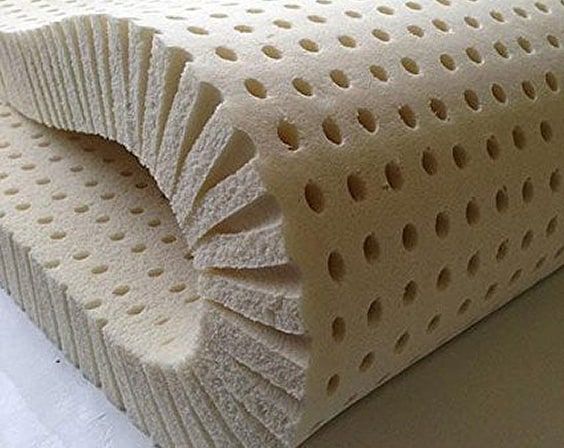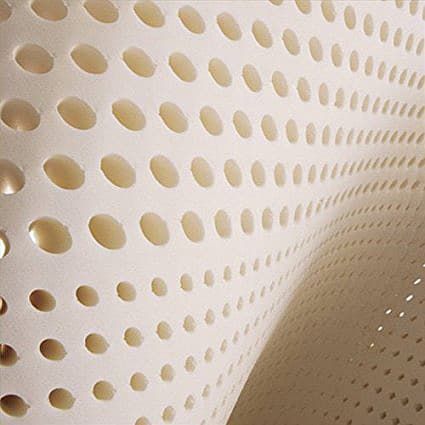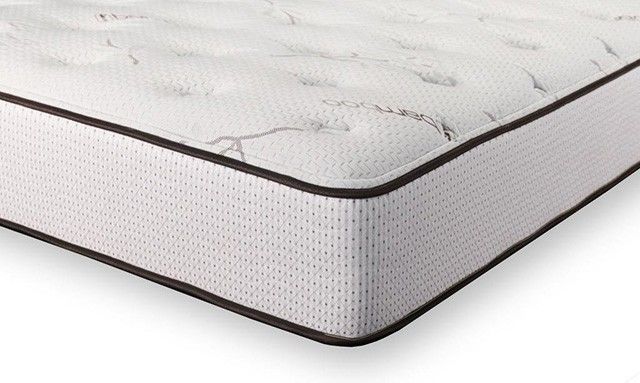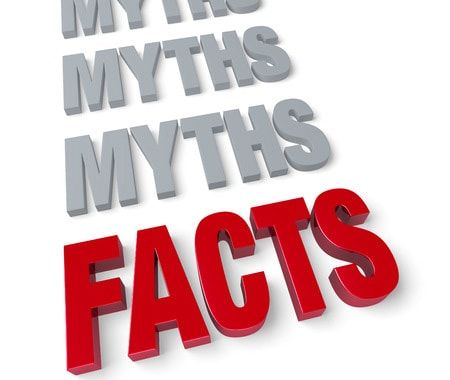If you’re looking for a quality product that you can count on standing the test of time, you’ve found the right page. Latex is a highly durable product that can be made naturally or synthetically, and, when you know what you’re looking for, you can find a latex mattress that will offer the unique features for your needs at a price you can afford. Take a moment to continue reading our latex mattress buying guide to see if this may be just the material you’ve been looking for.
You may be interested in: Best Latex Pillow
What is a Latex Mattress?
In general terms, latex is a milky fluid found in a variety of plants. When it’s exposed to air, it coagulates and changes into a solid form. For the purpose of latex production in the mattress industry, the sap of the rubber tree is used, and there are a few variations from which you’ll be able to choose as you shop. There are key differences to keep in mind, so pay close attention to ensure you find the one that works for your needs.
Natural Latex
Natural latex is carefully manufactured to keep the final product pure, and the following process walks you through how it’s made:
- Latex liquid is extruded from the Hevea-Brasilienis (rubber) tree by tapping much like is done when extracting syrup from the maple tree.
- Liquid is whipped up and placed in a mold.
- Mold is placed into a vulcanization oven.
- Latex foam is removed from the mold and washed.
- Product is heated to remove moisture.
There are two manufacturing processes that are slightly different, and these are known as Talalay and Dunlop. Both are capable of producing materials with a number of attractive properties like:
- Will last longer than most other mattress materials on the market
- Meets the most stringent textile and furniture emissions certifications
- Little offgassing
Talalay
Dunlop
The only drawback would be that they can sometimes contain small air pockets and other inconsistencies that make a little bit of a negative impact aesthetically.
What is Synthetic Latex?
Synthetic latex is similar to natural when it comes to overall physical properties, but it’s made from petrochemicals produced to mimic the properties of the natural alternative. Styrene-butadiene rubber is the most common type of synthetic latex, and, when you choose this option, you can often take advantage of a cheaper price. However, beware of a few pitfalls that come along with the lower cost.
- Material is more prone to tears than natural
- Durability is typically less than natural
- Usually lacks certifications from institutes like exolnstitut, Oeko-Tex and Greenguard
- Prone to strong offgassing
A Look At Blended Latex
It’s clear there are some major differences between natural and synthetic latexes. If you want to take advantage of a slightly lower cost while not losing the key components offered by natural latex, you may consider taking a look at blended latex products. The mattresses are produced as the name implies- blending natural and synthetic latex into one product.
It’s worth noting that some manufacturers will add only a minimal amount of natural latex and then brand their product as “made with 100% natural latex” or “contains natural latex.” Now, they aren’t lying, but they are clearly trying to make the product sound like something it’s not. If you are unsure as to the proportions of natural to synthetic in a blended product, it’s worth a call to customer service to find out before you make a purchase.
Latex Materials as a Comfort Layer
When used in the upper layers of a mattress, latex can be made with incredible softness to increase overall comfort. Indentation load deflection lets you get an idea of firmness, and I encourage you to read our complete ILD guide. As a reference, though, 12 is very soft and 50 is very firm. It’s not unusual to find a comfort level layer of latex to have an ILD as low as 14. The support you need is located in the lower levels of the product.
Great Contour
Much like memory foam, latex has the ability to conform well with your body as well as provide cradle, and this can be highly beneficial if you suffer with pressure points. However, unlike memory foam, you can easily change position using latex and don’t get that “stuck” feeling. Latex typically bounces back quickly when you remove pressure.
Durability Where It Really Counts
Especially if you’re purchasing a blended product, pay close attention to the material in the comfort layer as it’s here where most of the pressure is going to be applied. It’s at this layer where you’ll typically begin to notice wear and tear over time, so, ideally, it would do you well to look for a product which features natural latex at the comfort layer level. Even in its softer versions, you may be surprised at the amount of support this material is able to offer. This allows it to fill in the typically slimmer lumbar area of your body while still allowing cradle for the hips and shoulders.
A Word on Plush Natural Talalay
Natural Talalay latex with a very low ILD may be prone to quicker degradation due to it being lighter and less dense than both Dunlop and firm Talalay. It can still outlive the majority of other foam types, but, this is an example of a situation in which blended Talalay may be a preferable choice. Not to mention, you can usually pay a slightly lower price.
Since it’s usually able to be made softer than Dunlop, Talalay is a very popular choice in the comfort layer. It can also be specially-formulated to more efficiently transfer heat, a great quality if you tend to sleep hot. However, if you prefer a firmer product, Dunlop may be a better choice.
Latex Material as a Support Layer
We spend a lot of time speaking of ILD’s and densities, but there’s another component worth looking at when it comes to latex as a support layer. This is the product’s compression modulus, and this term describes its ability to conform to the body upon initial compression and to become firmer when deeper pressure is applied. Because of this specific quality, manufacturers are able to apply a support layer with ILDs as low as 28 while still maintaining the ability to support the heavier areas of your body and keep your spine aligned.
You may be interested in: Best Latex Mattress Toppers
Benefits of Latex Mattress
You can see already that latex offers a number of unique properties in the industry and can be a great solution for a large number of consumers. However, we all have our unique preferences, so let’s take a look at properties of latex in general that may fit your needs:
- Among the most durable in the industry, important if you’re ready to invest in a product that will last you awhile
- Can be made natural, a great quality if you like do what you can to be eco-friendly
- Over 33 percent of users of all-latex mattresses have reported a reduction in aches and pains.
- Limited to no off gassing, a great quality if you’re sensitive to volatile organic compounds.
- Low motion transfer, something you’ll appreciate if you have a sleeping partner.
- Customization often offered by the manufacturer.
Disadvantages of a Latex Mattress
I’m not here to sell you a latex mattress. Rather, it’s my goal to provide you with all the information you need to make the right decision for you. While there are plenty of reasons why you would want to explore this option, there are a few disadvantages you need to be aware of. Depending on your preferences, you may find one that’s an absolute no-go.
- Sometimes the firmness is a little higher during the first 30 days or so, so it can take some time to break the material in.
- Compression can begin to occur over time in synthetic products. If you have a sleeping partner or carry a lot of weight individually, I’d recommend a natural or blended product.
- Natural products can be expensive. However, when you shop online, you can often order straight from the manufacturer, and this eliminates overhead.
- Mattress can be heavy, and this can hinder you if you’ll need to move the product often.
How to Choose a Latex Mattress
I’ve had the chance to try out several latex products, the most recent being the Avocado mattress which features eco-INSTITUT-certified natural Dunlop latex. I have been very happy thus far. If you feel latex may be a good choice, I’d like to walk you through a quick checklist to ensure you don’t overlook anything.
Understanding ILD
- Generally, 12 is very soft while 50 is very firm. If you prefer a medium product, you should shoot from around 25 to 31. Just remember as you shop that we’re referring to the ILD of the product as a combined unit. As you analyze layers, you’ll typically find lower numbers at the comfort level.
Trials
- Trial periods will show you how confident a company is in their product. I have tried out latex products that allow trial periods as long as 200 nights.
Durability
- Among the most durable products in the mattress industry
- Since they often feature various comfort layers, you can oftentimes change one layer when it begins to degrade without having to replace the entire unit.
- Synthetic products don’t last as long as natural, but they can be acquired for a cheaper price.
Support and Comfort
- Offers unique combination of contour and support that helps keep your spine aligned.
- At the support level, latex is able to become firmer when deeper pressure is applied, allowing for an ILD as low as 28 to suffice.
- Offers lumbar support and cradle for the hips and shoulders
Heat Retention
- Less than 10 percent of all-latex users report sleeping hot.
- Talalay latex is manufactured in a way that creates breathable chambers within the material to help aid in heat transfer.
- Synthetic products are prone to sleep hotter than natural ones.
- Consider the various layers and analyze how you can expect them to perform individually.
Offgassing
- For natural, all-latex beds, there is little report of any off gassing.
- Rubber does have a smell, and a small percentage report detecting this slight odor during the first day or two after opening their mattress.
- High quality foam is often thoroughly washed, something to consider investing in if smell is an important factor for you.
- Natural materials like wool and cotton can help reduce off gassing.
- Choose an unglued product of possible.
- Avoid synthetic material. They use certain components during manufacturing that are known to off gas.
Company Reputation
- Take time to read about the company’s background and mission. You can typically find an “About Us” button on manufacturers’ websites.
- You will often find a correlation in the age of the company and their confidence to offer sleep trials. The longer they’ve been in business, the more they have learned from customer feedback.
- Don’t just trust their age. Take advantage of mattress comparison guides online to get a good feel of what’s out there. Reviews can provide you with first-hand knowledge of what to expect based on the experiences of real consumers.
When to Choose a Latex Mattress
Is latex the best choice for everyone? Certainly not. However, it’s a highly versatile product that’s accommodating for a large number of sleepers. Latex may be a great choice for you if:
- You suffer with pressure points
- You carry a lot of weight
- You’re looking for a product that will last
- You want to avoid off gassing
- You sleep hot
- You have a sleeping partner and want to keep motion transfer low
- You are looking for the ability to customize.
- You want the ability to be eco-friendly in your mattress shopping with natural options
- You appreciate options in firmness to accommodate back, stomach and side sleepers
When NOT to Choose a Latex Mattress
There are many different mattress products out there, and, depending on your preferences, latex may just not be your best option. A few reasons you may want to look elsewhere include:
- You don’t want a product that may take some time to break in. Firmness may be a little higher during the first 30 days.
- Products can be pricey, especially if they’re natural. You can choose synthetic, but they are known to off gas and probably won’t last as long as natural. Blended products can be a good middle ground.
- You anticipate you’ll be moving frequently as these products can be heavy.
Common Misconceptions
As with most products, there are a few misconceptions out there that I think are worth taking a moment to clear up. We all know how quickly a rumor can spread, and this can cause us to make false judgements about those around us. The same is true when it comes to latex mattresses.
- All latex mattresses are expensive.
This is simply not true. While they can cost as much as $5,000, you can find quality products online for a fraction of that cost. Keep in mind that you can typically expect higher durability in a larger investment. But, if money’s tight, there are many options out there. - They are too firm.
As mentioned, the firmness level can be a little high at first, but you’ll often notice that
they plush up once you give around 30 days to fully break in. - They are bad for the environment.
A typical oil spring mattress will probably last you around 5-8 years. However, an
all-natural latex mattress can last more than 20. Not to mention, they are biodegradable. - Some people are allergic to latex and shouldn’t sleep on a latex mattress.
Less than one percent of the population is allergic to latex. Most incidents of reactions are due to direct contact with latex rubber. However, in the mattress industry, latex is contained inside a fabric casing. More on latex allergies latex allergies here.
You may be interested in: Latex for Less Review
Frequently Asked Questions
What’s the difference between natural, synthetic, and blended?
- Natural products don’t add various chemicals that are added during synthetic production. While synthetic is typically cheaper they don’t last as long. A blended product combines the synthetic and natural latex and helps to lower the cost. Natural latex is the best quality.
What’s the difference between Talalay and Dunlop latex?
- Talalay advances the traditional Dunlop process a bit, and it can add heat transfer capabilities. I encourage you to take a look at our complete Talalay vs. Dunlop guide. It’s complete with a video to show you the Talalay process in action.
How much latex must there be in a product for it to be called a latex mattress?
- There are no laws dictating how much latex must be in a mattress for it to be considered such. Because of this, I would highly encourage you to do your research before making an investment. If you need to call customer service, that’s what they’re there for. If the price seems too good to be true, there’s a good chance the actual percentage of quality latex in the product is minimal.
What ILD should I look for?
- For a firm product, shoot for an ILD above 31.
- For a medium product, 25-31 should do the trick
- For a plush product, less than 25
Should you invest in a glued product?
- Some say that latex layers, when not glued, tend to move around inside the cover. In my experience, I have not found this to be true. You have to understand that latex is very abrasive, and it naturally grabs onto most surfaces it comes into contact with. When products are glued, it also requires that you replace your entire mattress rather than a single layer if the need to do so ever arose.
What Should I Look for In Quality Customer Service?
- Quality customer service is something we typically don’t consider until we’ve already made a purchase and have a problem. I’d encourage you not to let it get to that point. Before you buy, it’s a good idea to:
- Call customer service with a few of your questions. How long does it take to reach an agent? Do they offer online chat support? Do they offer follow-up assistance?
- Do associates put pressure on you to buy and seem to avoid providing direct answers?
- How do reviewers of the product feel about customer service? You can learn a lot from the experiences of others.
Shopping With a Purpose
As you consider the types of latex mattresses out there, I hope this buying guide has proven beneficial. We have covered the important factors to be aware of as you shop as well as the many pros along with the cons of latex mattress material. To break it down quite simply, you should:
- Test products carefully using this guide. Don’t forget to consider indentation load deflection, comfort and point elasticity options.
- Review the free trial and warranty of the product.
- Carefully analyze the various comfort layers and the ILDs found at each.
- Weigh the benefits of natural latex as well as the downsides of synthetic to determine if you want to compromise or perhaps choose a blended product.
- Narrow down your options to those which meet your individual needs and compare quality reviews to make the best pick.
It’s our goal here at The Sleep Judge to help you find the right sleep products to meet your needs. The right latex mattress can offer many years of satisfaction. If you have comments or questions, please leave them below and we’ll get back to you with a detailed answer to point you in the right direction.
You may want to read: Latex Mattress Allergies – What You Need To Know
